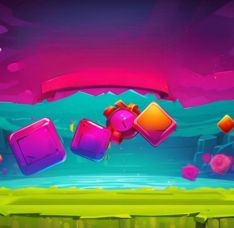
Geometry Dash Review
Navigating through explosive colors, pulsating lights, and geometric obstacles to an entrancing soundtrack, welcome to the electrifying universe of Geometry Dash. Developed by Swedish game developer Robert Topala and launched by company RobTop Games, Geometry Dash embodies the spirit of rhythmic-based platformers. Since it made its first appearance in 2013, the game has undergone continuous transformation and growth, with amendments improving gameplay and design. Celebrated for its innovative combination of rhythm, movement, and geometry, the game continues to enchant players of diverse skill levels right across the world.
Diving Deep into the Rhythm
The fundamental principle of Geometry Dash's gameplay is misleadingly simple: players maneuver a small cube (and later other shapes) across a path filled with hindrances, with the primary goal being to reach the end without colliding with any obstacles. It operates on a touch control mechanism, where the player makes the cube jump by tapping the screen. What adds the magnetic allure of the game, however, is the musical element. Jumping obstacles are in precise synchronization with the exhilarating background music, making navigation not only a visual experience but a rhythmic one.
The game includes 21 official levels, each set to their distinctive music, aesthetics, and difficulty grade. Apart from built-in levels, an integral part of Geometry Dash's gameplay is the level editor feature that allows its players to design and share their customized game levels. This element of user-generated content positively feeds the game's longevity and communal socialist interaction.
Setting Geometry Dash Apart: Spotlight on Uniqueness
Despite being a part of the vast ocean of platform games, Geometry Dash sets itself apart with its innovative blend of simple gameplay, challenging platforming elements, and the rhythmic synchronization of actions.
One of the standout characteristics is the game’s seamless integration of background music with gameplay. Unlike many of its counterparts, every jump and slide in Geometry Dash is perfectly timed with the rhythm, creating an immersive and visceral experience. This stands in contrast to games like Super Mario Run or Donkey Kong, where the music while engaging, doesn't dictate gameplay.
Another nomination for its unique stature is the use of geometric shapes and designs, ditching the widespread human or animal characters generally used in similar games. Your diverse avatars, ranging from a square to a UFO, wave, ball, robot, and spider, all add to the game's individualistic branding.
Further differentiating itself from its competitors, Geometry Dash places a significant emphasis on user-generated content. The level editor is a key part of the Geometry Dash experience. This feature allows players to design, build, and share their levels for others to enjoy, a level of freedom not seen in many platformers where playthroughs are often strictly linear and designed by the developers. In Geometry Dash, players control not only their geometric avatar but also the creation of new worlds for others to explore.
When pitted against other games, such as Flappy Bird or Jetpack Joyride, which bank on simple avoidance mechanics, Geometry Dash brings an added layer of complexity with its demanding level designs and instant-touch response mechanism, this makes the gameplay a test of timing, precision, and, ultimately patience.
Geometry Dash refrains from littering the gameplay screen with any score tabs or lives count, keeping the focus strictly on the gameplay. This minimalist approach ensures players are not distracted and can fully immerse themselves in the rhythm-based platforming action.
Geometry Dash shines in its unique combination of rhythm-based gameplay, a focus on geometric design, incorporation of user-generated content, and a minimalist interface. By challenging the norms of platform games, the game has established its distinctive identity, leaving its vibrant geometrical imprint on the gaming world.
Gameplay Weaknesses
Despite the thrilling experience Geometry Dash provides, it's important to spotlight its weaknesses, too. Notably, the absence of in-level checkpoints can frustrate players, especially at higher stages where levels can get exceedingly intricate. Losing means returning to the start, regardless of how close one was to finishing the level. This can sometimes lead to repetitive gameplay, noted as a negative aspect by some players. Another critique points to the limited tutorial, leaving newcomers to figure out game mechanics themselves, which can be daunting and overwhelming.
Players Speak - Impressions on Geometry Dash
Collecting players’ testimonies, the usual agreement lies in the fact that the game delivers an adrenaline-rush experience that's handsomely rewarding and incredibly contagious. For many players, the game sells more than a chance to overcome geometric hurdles; and it presents an opportunity to improve reflexes and enhance rhythm perception - all set to an impressive set of soundtracks. Criticisms often center around the high difficulty level and the frustration of not having any checkpoints in the levels.
In summing up, here's an overview of Geometry Dash's pros and cons:



